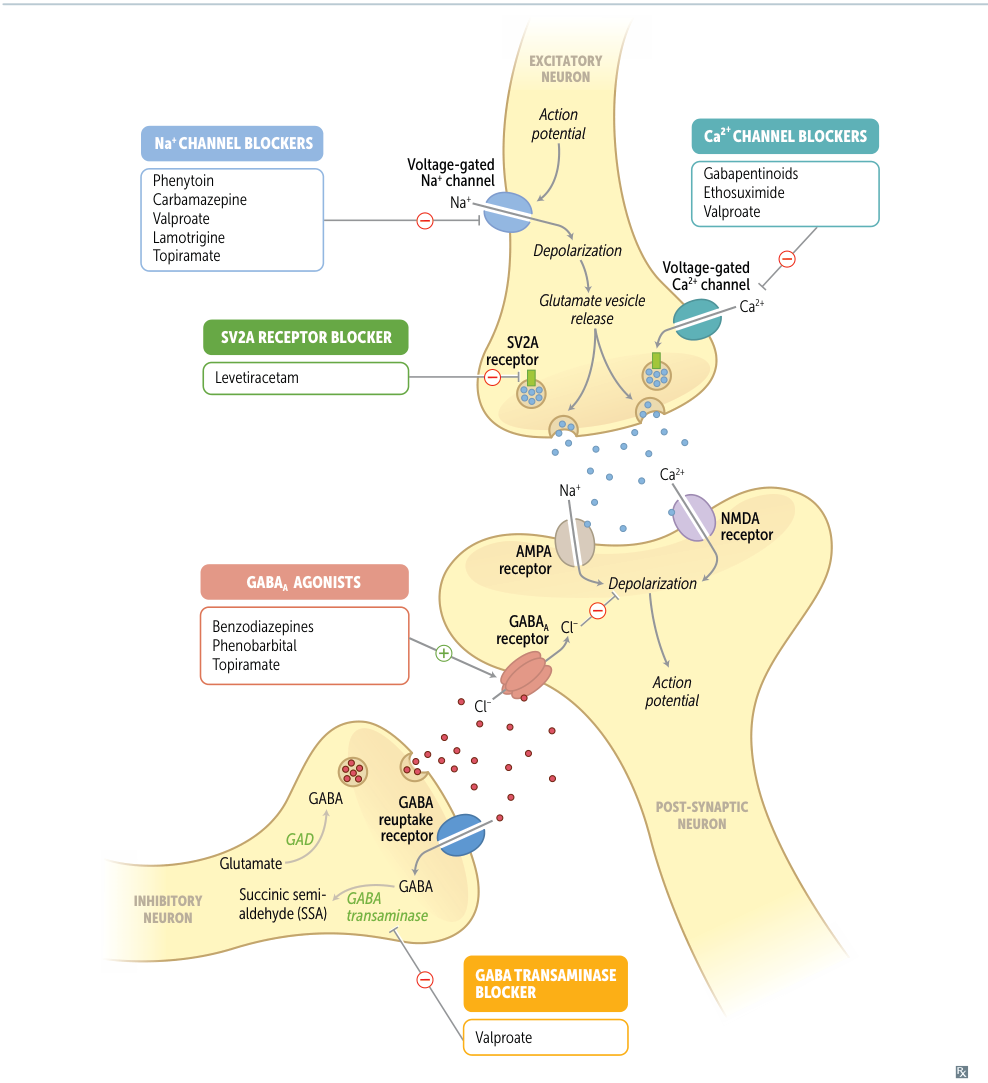Sedative-hypnotic drugs

Benzodiazepines
Agents
- Short-acting (half-life 1–12 hours): Triazolam, Oxazepam, and Midazolam
- Intermediate-acting (half-life 12–40 hours): lorazepam, clonazepam, alprazolam, temazepam
- Long-acting (half-life > 40 hours): diazepam, chlordiazepoxide,
Mnemonic
- All contain AZE from Benzodiazepine
- Separate short , intermediate , and long-acting benzodiazepines with the phrase:
- TOM moved fast , to lure the CAT , but still took several días (Spanish for days) .
Adverse effects
Benzodiazepine overdose
- Clinical features
- Sedation with normal vital signs
- Slurred speech, ataxia
- Treatment
- Antidote: flumazenil
- Mechanism of action: competitive antagonism at GABA receptor
- Antidote: flumazenil
Benzodiazepine dependence
Warning
Benzodiazepine dependence can already develop after a few weeks of use. Therefore, benzodiazepines should only be prescribed when strongly indicated.
- Withdrawal symptoms
- Autonomic nervous system
- Diaphoresis
- Nausea, vomiting, and anorexia
- Tachycardia
- Hypertension
- Neurological
- Seizures
- Less sensitive/fewer GABA receptors → CNS hyperexcitability
- Tremors
- Memory impairment
- Seizures
- Psychiatric
- Anxiety
- Depressive mood
- Insomnia
- Autonomic nervous system
Mnemonic
Flum-AZE-NIL = turns benzos into nothing
Barbiturates
| Feature | Barbiturates | Benzodiazepines |
|---|---|---|
| Mechanism of Action | Act on GABAA receptors, enhancing GABA activity | Act on GABAA receptors, enhancing GABA activity |
| Potency | Generally more potent | Generally less potent |
| Safety Profile | Higher risk of overdose and addiction | Lower risk of overdose and addiction |
| Sedative Effect | Strong sedative effects | Moderate sedative effects |
| Duration of Action | Short to long duration depending on the type | Short to intermediate duration |
| Metabolism | Metabolized by liver enzymes | Metabolized by liver enzymes |
| Indications | Historically used as sedatives, anesthetics, and anticonvulsants | Primarily used as anxiolytics, sedatives, and muscle relaxants |
| Withdrawal | Severe withdrawal symptoms, including seizures | Generally milder withdrawal symptoms |
| Risk of Dependence | High risk of physical and psychological dependence | Lower risk of physical and psychological dependence |
| Examples | Phenobarbital, Pentobarbital, Secobarbital, Primidone: essential tremor | Diazepam, Alprazolam, Lorazepam, Clonazepam |
Nonbenzodiazepine hypnotics (Z-drugs)
Agents
- Zolpidem (imidazopyridine): half-life ∼ 2 hours
- Brand name: Stilnox
- Zaleplon (pyrazolopyrimidine): half-life ∼ 1 hour
- Eszopiclone: half-life ∼ 6 hours
Mechanism of action
- Similar to benzodiazepines
- Selectivity for GABAA receptors with α1 subunits (corresponding to the BZ1 subtype)
- Short-acting due to fast metabolization by liver enzymes
Melatonin agonists
Agents
- Ramelteon
- Tasimelteon
- Agomelatine
Mnemonic
Ramelteon, tasimelteon, and agomelatine are melatonin receptor agonists.
Mechanism of action
- Activation of MT1 and MT2 receptors in suprachiasmatic nuclei of the hypothalamus → quicker sleep onset
- Do not cause dependence
Indications
- Insomnia, especially in older adults
- Because of its low risk of adverse effects, rameleton is a preferred option in older patients, who are particularly sensitive to the adverse reactions of sedative pharmacotherapy.
Adverse effects
- Headache
- Dizziness
- Fatigue
- Nausea